Do you have a question about the Panasonic KX-FT31BX and is the answer not in the manual?
Step-by-step instructions for correctly installing the recording paper roll into the unit.
Guide on connecting the telephone line, handset, and power cord to the facsimile unit.
Instructions for initiating, answering, and ending voice calls using the handset.
Procedure for manually sending fax documents through the document feeder.
Steps for answering and receiving incoming faxes manually.
Instructions on how to use the unit as a photocopier.
Essential safety guidelines to reduce risk of fire, electric shock, or personal injury.
Specific warnings for installation, operation, and environmental conditions.
Details the items provided with the facsimile unit upon purchase.
How to print assistance guides for unit operations.
Diagram and explanation of the unit's buttons and their functions.
Identification of key external parts of the facsimile unit.
Step-by-step guide for loading the recording paper roll.
Instructions for connecting the handset, line, and power cables.
How to set the unit's date, time, and facsimile telephone number.
Procedure for programming a custom logo for outgoing faxes.
Methods for inputting characters using the dial keypad or EASY DIAL.
Guide to programming the unit's facsimile telephone number.
How to adjust the ringer, handset, and monitor speaker volumes.
Manual steps for making, answering, and muting voice calls.
Explanation of special dialing buttons and their uses.
How to store, edit, and erase names and numbers in the directory.
Using the EASY DIAL directory to initiate voice calls.
Enabling conversations after fax transmission or reception.
Step-by-step process for sending faxes without using the directory.
Procedure for sending faxes via the stored EASY DIAL directory.
Specifications and restrictions for documents that can be faxed.
Configuring and understanding fax transmission and journal reports.
Setting up faxes to be sent automatically at a later time.
Adjusting settings for easier overseas fax transmission.
Allowing another machine to retrieve a fax from this unit.
Overview of the four different modes for receiving calls and faxes.
Manual answering of all incoming voice and fax calls.
Automatically receiving all calls as faxes.
Receiving voice calls with rings and fax calls silently.
Using the unit with an external telephone answering machine.
Using different ring patterns to identify call types.
Receiving faxes remotely using an extension phone.
Retrieving faxes from another compatible machine.
Enabling fax reception from older models without fax tones.
Setting up the unit to signal your pager upon receiving a fax.
Instructions on how to use the unit as a photocopier.
Explanation of error codes appearing on transmission and journal reports.
Troubleshooting guide for messages shown on the unit's display.
Solutions for common issues like call, work, or ring problems.
Troubleshooting steps for problems sending documents.
Solutions for problems receiving documents automatically or clearly.
Troubleshooting steps for distorted or blank copied documents.
Resolving problems when using an external answering machine.
What happens to the unit and its memory during a power outage.
Procedure to remove jammed recording paper.
How to resolve issues with documents not feeding or feeding multiple pages.
Instructions for cleaning the document feeder rollers and parts.
Guide for cleaning the thermal head for better print quality.
How to print lists of basic and advanced feature settings.
Generating a list of stored names and numbers from the EASY DIAL.
How to print the record of recent fax transmissions and receptions.
Steps to change the contrast of the unit's LCD screen.
Procedure to return advanced features to their original pre-selected settings.
Overview of user-configurable basic features and their settings.
Overview of user-configurable advanced features and their settings.
Detailed technical specifications, dimensions, and power requirements.
Step-by-step instructions for correctly installing the recording paper roll into the unit.
Guide on connecting the telephone line, handset, and power cord to the facsimile unit.
Instructions for initiating, answering, and ending voice calls using the handset.
Procedure for manually sending fax documents through the document feeder.
Steps for answering and receiving incoming faxes manually.
Instructions on how to use the unit as a photocopier.
Essential safety guidelines to reduce risk of fire, electric shock, or personal injury.
Specific warnings for installation, operation, and environmental conditions.
Details the items provided with the facsimile unit upon purchase.
How to print assistance guides for unit operations.
Diagram and explanation of the unit's buttons and their functions.
Identification of key external parts of the facsimile unit.
Step-by-step guide for loading the recording paper roll.
Instructions for connecting the handset, line, and power cables.
How to set the unit's date, time, and facsimile telephone number.
Procedure for programming a custom logo for outgoing faxes.
Methods for inputting characters using the dial keypad or EASY DIAL.
Guide to programming the unit's facsimile telephone number.
How to adjust the ringer, handset, and monitor speaker volumes.
Manual steps for making, answering, and muting voice calls.
Explanation of special dialing buttons and their uses.
How to store, edit, and erase names and numbers in the directory.
Using the EASY DIAL directory to initiate voice calls.
Enabling conversations after fax transmission or reception.
Step-by-step process for sending faxes without using the directory.
Procedure for sending faxes via the stored EASY DIAL directory.
Specifications and restrictions for documents that can be faxed.
Configuring and understanding fax transmission and journal reports.
Setting up faxes to be sent automatically at a later time.
Adjusting settings for easier overseas fax transmission.
Allowing another machine to retrieve a fax from this unit.
Overview of the four different modes for receiving calls and faxes.
Manual answering of all incoming voice and fax calls.
Automatically receiving all calls as faxes.
Receiving voice calls with rings and fax calls silently.
Using the unit with an external telephone answering machine.
Using different ring patterns to identify call types.
Receiving faxes remotely using an extension phone.
Retrieving faxes from another compatible machine.
Enabling fax reception from older models without fax tones.
Setting up the unit to signal your pager upon receiving a fax.
Instructions on how to use the unit as a photocopier.
Explanation of error codes appearing on transmission and journal reports.
Troubleshooting guide for messages shown on the unit's display.
Solutions for common issues like call, work, or ring problems.
Troubleshooting steps for problems sending documents.
Solutions for problems receiving documents automatically or clearly.
Troubleshooting steps for distorted or blank copied documents.
Resolving problems when using an external answering machine.
What happens to the unit and its memory during a power outage.
Procedure to remove jammed recording paper.
How to resolve issues with documents not feeding or feeding multiple pages.
Instructions for cleaning the document feeder rollers and parts.
Guide for cleaning the thermal head for better print quality.
How to print lists of basic and advanced feature settings.
Generating a list of stored names and numbers from the EASY DIAL.
How to print the record of recent fax transmissions and receptions.
Steps to change the contrast of the unit's LCD screen.
Procedure to return advanced features to their original pre-selected settings.
Overview of user-configurable basic features and their settings.
Overview of user-configurable advanced features and their settings.
Detailed technical specifications, dimensions, and power requirements.
| Brand | Panasonic |
|---|---|
| Model | KX-FT31BX |
| Category | Fax Machine |
| Language | English |



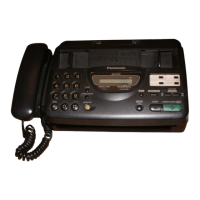

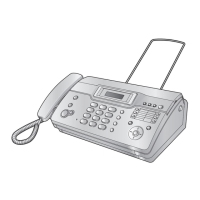
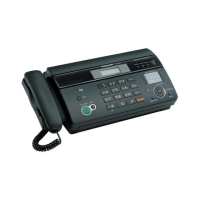

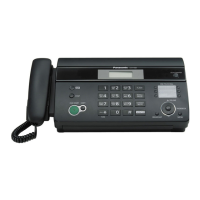
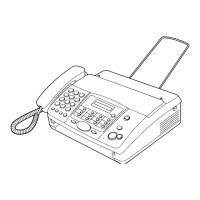
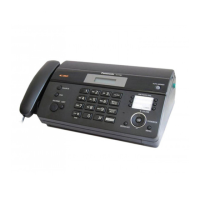
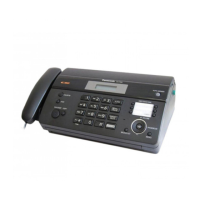
